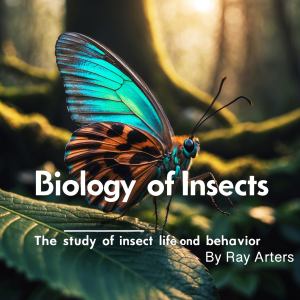

Biology of Insects
Ray Arters
This audiobook is narrated by a digital voice.
Insects represent the most successful group of animals on Earth, comprising over 80% of all known animal species and occupying virtually every ecological niche from deep ocean trenches to high mountain peaks. Their extraordinary success stems from a fundamental body plan that has proven remarkably adaptable across millions of years of evolution, enabling insects to exploit resources and environments unavailable to other organisms. Understanding insect biology begins with examining their basic architecture, which provides the foundation for their incredible diversity and ecological dominance.
The segmented body plan of insects reflects their arthropod heritage while incorporating specialized features that distinguish them from other members of this diverse phylum. The insect body consists of three distinct regions: the head, thorax, and abdomen, each serving specific functions that contribute to survival and reproduction. This tagmatization, or division into specialized body regions, allows for efficient organization of sensory organs, locomotory structures, and internal systems while maintaining the structural integrity necessary for terrestrial life.
The exoskeleton represents perhaps the most defining feature of insect anatomy, providing both protection and structural support through a complex arrangement of sclerotized plates connected by flexible membranes. Composed primarily of chitin embedded in a protein matrix, the exoskeleton serves multiple functions including muscle attachment, water conservation, and defense against predators and environmental hazards. The cuticle's multilayered structure includes an outer epicuticle that provides waterproofing through waxy secretions, a middle exocuticle that provides strength through cross-linked proteins, and an inner endocuticle that offers flexibility and growth accommodation.
Duration - 1h 2m.
Author - Ray Arters.
Narrator - Digital Voice Archie G.
Published Date - Friday, 24 January 2025.
Copyright - © 2025 Ray Arters ©.
Location:
United States
Description:
This audiobook is narrated by a digital voice. Insects represent the most successful group of animals on Earth, comprising over 80% of all known animal species and occupying virtually every ecological niche from deep ocean trenches to high mountain peaks. Their extraordinary success stems from a fundamental body plan that has proven remarkably adaptable across millions of years of evolution, enabling insects to exploit resources and environments unavailable to other organisms. Understanding insect biology begins with examining their basic architecture, which provides the foundation for their incredible diversity and ecological dominance. The segmented body plan of insects reflects their arthropod heritage while incorporating specialized features that distinguish them from other members of this diverse phylum. The insect body consists of three distinct regions: the head, thorax, and abdomen, each serving specific functions that contribute to survival and reproduction. This tagmatization, or division into specialized body regions, allows for efficient organization of sensory organs, locomotory structures, and internal systems while maintaining the structural integrity necessary for terrestrial life. The exoskeleton represents perhaps the most defining feature of insect anatomy, providing both protection and structural support through a complex arrangement of sclerotized plates connected by flexible membranes. Composed primarily of chitin embedded in a protein matrix, the exoskeleton serves multiple functions including muscle attachment, water conservation, and defense against predators and environmental hazards. The cuticle's multilayered structure includes an outer epicuticle that provides waterproofing through waxy secretions, a middle exocuticle that provides strength through cross-linked proteins, and an inner endocuticle that offers flexibility and growth accommodation. Duration - 1h 2m. Author - Ray Arters. Narrator - Digital Voice Archie G. Published Date - Friday, 24 January 2025. Copyright - © 2025 Ray Arters ©.
Language:
English
Biology of Insects
Duration:01:02:55